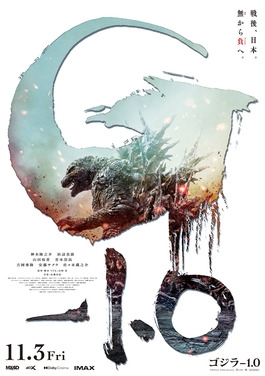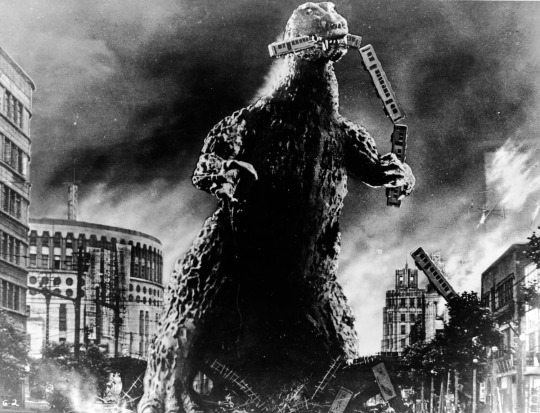Don't wanna be here? Send us removal request.
Text
Later Films Kaiju Cinema: Godzilla Minus One Evolves the Genre
"Godzilla Minus One" marks a significant departure from the traditional Godzilla films of the 1950s and 1960s, embodying a shift in both filmmaking techniques and thematic depth within the kaiju genre. This modern adaptation delves into the psychological complexities of its titular character, portraying Godzilla not merely as a destructive force of nature, but as a tragic figure grappling with existential angst and the consequences of its own existence.
Unlike its predecessors, which often depicted Godzilla as a symbol of nuclear devastation or a generic monster wreaking havoc on Tokyo, "Godzilla Minus One" explores the emotional turmoil of the creature, humanizing it in a way that resonates with contemporary audiences. Through stunning visual effects and nuanced performances, the film delves into Godzilla's inner turmoil, presenting a layered portrayal of a creature torn between its instinctual nature and a desire for redemption.
Furthermore, "Godzilla Minus One" reflects the evolution of filmmaking technology, employing state-of-the-art CGI to bring its monstrous protagonist to life in a manner that surpasses the practical effects of the past. This allows for greater flexibility in storytelling and visual spectacle, enabling filmmakers to create more dynamic and immersive kaiju battles while also conveying the emotional depth of the characters involved.
In contrast, the Godzilla films of the 1950s and 1960s were products of their time, characterized by their use of practical effects, rubber suits, and miniature sets. While these films were groundbreaking in their own right and laid the foundation for the kaiju genre, they often lacked the narrative complexity and visual sophistication of a contemporary production such as Godzilla Minus One.
youtube


0 notes
Text
The Influence of Japanese Kaiju films on other directors: Guillermo del Toro
The influence of Japanese Kaiju films from the 1950s and 1960s is profound, especially on filmmakers who grew up watching these iconic monster movies. A primary example of this is critically acclaimed filmmaker Guillermo del Toro and his film Pacific Rim.
In "Pacific Rim," del Toro presents a world where giant monsters, known as Kaiju, emerge from an interdimensional portal beneath the Pacific Ocean to wreak havoc on humanity. In response, humanity constructs massive humanoid robots called Jaegers to combat the Kaiju. The film's premise directly mirrors the formula of classic Kaiju films, where giant monsters threaten civilization, and humanity fights back with a nearly equally colossal defense.
Del Toro's love for the spectacle and mythology of Kaiju movies is evident in the design of both the monsters and the Jaegers. The Kaiju are diverse in appearance, ranging from reptilian behemoths to insectoid nightmares, reminiscent of the varied creatures seen in the classic Kaiju films of the 1950's and 60's. Each Jaeger is also distinct, with its own unique design and weaponry, echoing the iconic giant robots of Japanese pop culture.
Beyond the visual homage, del Toro infuses "Pacific Rim" with his own themes and motifs. The film explores themes of teamwork, sacrifice, and humanity's resilience in the face of overwhelming odds, all of which are recurring themes in classic Kaiju storytelling. However additionally, del Toro imbues his monsters and robots with a sense of personality and character, and in an interview, stated that each character's personal story was just as or possibly more important than creating the action scenes in the film.
youtube
youtube


0 notes
Text
Godzilla (1954) Film Spotlight
Godzilla, the colossal, irradiated reptilian creature, has left an indelible mark on popular culture. Beyond its initial impact as a towering monster wreaking havoc on Tokyo, Godzilla's significance extends far deeper, touching on themes of nuclear anxiety, environmentalism, and the consequences of humanity's hubris in his first film, Godzilla from 1954.
on Odo Island, the citizens of the local fishing community are unable to catch anything. Masaji Yamada, a local fisherman and the only survivor from the most recent shipwreck, washes ashore on a raft and tells the islanders that something sank his boat. An elder says that Godzilla must be the cause, though many of the younger islanders are hesitant to believe the superstition. According to local folklore, Godzilla is a kaiju who lives in the sea that comes from the ocean to feed on mankind. Whenever fishing was poor, the islanders once sent young women adrift on rafts as a sacrifice to prevent Godzilla from coming ashore.
Godzilla eventually surfaces from Tokyo Bay. The monster easily breaks through a previously constructed giant electric fence, with no pain inflicted. The bombardment of artillery shells from the JSDF also has no effect. As Godzilla breaks through the high-tension wires, he spits a stream of superheated radioactive vapor from his mouth to melt the electric fence. Godzilla continues to move inland, reaching the heart of Tokyo and setting it ablaze with his atomic breath. The JSDF's tanks and artillery are also useless against Godzilla, who continues his raid well into the night. By the end, the entire city is destroyed and thousands of innocent civilians are dead, dying, or wounded. As Godzilla wades back into Tokyo Bay, a squadron of jets fire rockets at the monster, which while they do not phase Godzilla though do manage to lead him out to sea, where he disappears beneath the waves.
One of the most pivotal scenes in "Godzilla" is this assault on Tokyo. As the monstrous creature emerges from Tokyo Bay, the city is plunged into chaos, with buildings crumbling, fires raging, and civilians fleeing in terror. This scene serves as a visceral depiction of the destructive power of nuclear weapons, evoking the horror and helplessness felt by the Japanese people in the wake of World War II.


youtube
0 notes
Text
Legacy of the Monsters: Iconic Japanese Kaiju from the 1950s and 1960s
The 1950s and 1960s marked a transformative period in the history of Japanese cinema, particularly with the emergence of kaiju films. Kaiju, a Japanese term meaning "strange beast" or "monster," became synonymous with a subgenre of science fiction and fantasy films featuring giant creatures wreaking havoc on cities and battling each other. This era saw the birth of iconic monsters and visionary filmmakers who revolutionized the genre, laying the groundwork for a cinematic legacy that continues to captivate audiences worldwide.
The roots of kaiju cinema can be traced back to the aftermath of World War II, a time of profound social and cultural upheaval in Japan. The devastation wrought by the war, coupled with the anxieties surrounding the atomic bombings of Hiroshima and Nagasaki, deeply influenced the collective psyche of the Japanese people. It was against this backdrop of fear and uncertainty that the first kaiju film, "Godzilla" (1954), emerged. Directed by Ishirō Honda and produced by Tomoyuki Tanaka, "Godzilla" was a powerful allegory for the horrors of nuclear warfare and the dangers of unchecked scientific experimentation. The titular monster, a prehistoric creature awakened and mutated by nuclear testing, served as a terrifying embodiment of the destructive power of atomic energy. The film struck a chord with audiences, resonating not only as a thrilling monster movie but also as a poignant reflection on the trauma of war.
Following the immediate success of "Godzilla," a wave of kaiju films flooded Japanese cinemas throughout the 1950s and 1960s. These films often featured a formulaic narrative structure, typically revolving around the emergence of a giant monster or monsters threatening humanity, followed by the efforts of brave protagonists to combat the creature(s) and restore order. One of the most enduring aspects of kaiju cinema from this era was the collaboration between director Ishirō Honda and special effects master Eiji Tsuburaya. Tsuburaya's innovative techniques, including suitmation (actors in monster suits) and miniature sets, brought the towering creatures to life in spectacular fashion. His work on films like "Godzilla," "Rodan" (1956), and "Mothra" (1961) set the standard for special effects in kaiju cinema and paved the way for future filmmakers to push the boundaries of visual storytelling with their special effects.
The popularity of kaiju cinema also gave rise to a pantheon of iconic monsters, each with their own distinct personalities and abilities. From Godzilla to Mothra and the fearsome King Ghidorah, these creatures captured the imagination of audiences and became cultural icons in their own right. Beyond their entertainment value, kaiju films of the 1950s and 1960s served as vehicles for exploring complex themes and social commentary. Whether addressing concerns about nuclear proliferation, environmental degradation, or the consequences of scientific hubris, these films offered audiences a lens through which to examine contemporary issues and anxieties.

1 note
·
View note